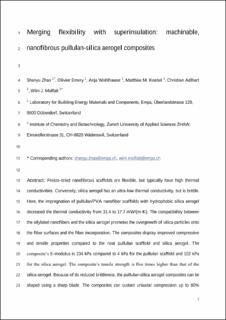Please use this identifier to cite or link to this item:
https://doi.org/10.21256/zhaw-1452| Publication type: | Article in scientific journal |
| Type of review: | Peer review (publication) |
| Title: | Merging flexibility with superinsulation : machinable, nanofibrous pullulan-silica aerogel composites |
| Authors: | Zhao, Shanyu Emery, Olivier Wohlhauser, Anja Koebel, Matthias M. Adlhart, Christian Malfait, Wim J. |
| DOI: | 10.21256/zhaw-1452 10.1016/j.matdes.2018.09.010 |
| Published in: | Materials & Design |
| Volume(Issue): | 160 |
| Page(s): | 294 |
| Pages to: | 302 |
| Issue Date: | 2018 |
| Publisher / Ed. Institution: | Elsevier |
| ISSN: | 0264-1275 0261-3069 1873-4197 |
| Language: | English |
| Subjects: | Nanocomposite; Polysaccharide; Nanofibers; Hybrid aerogels; Densification |
| Subject (DDC): | 540: Chemistry 620: Engineering |
| Abstract: | Freeze-dried nanofibrous scaffolds are flexible, but typically have high thermal conductivities. Conversely, silica aerogel has an ultra-low thermal conductivity, but is brittle. Here, the impregnation of pullulan/PVA nanofiber scaffolds with hydrophobic silica aerogel decreased the thermal conductivity from 31.4 to 17.7 mW/(m·K). The compatibility between the silylated nanofibers and the silica aerogel promotes the overgrowth of silica particles onto the fiber surfaces and the fiber incorporation. The composites display improved compressive and tensile properties compared to the neat pullulan scaffold and silica aerogel. The composite's E-modulus is 234 kPa compared to 4 kPa for the pullulan scaffold and 102 kPa for the silica aerogel. The composite's tensile strength is five times higher than that of the silica aerogel. Because of its reduced brittleness, the pullulan-silica aerogel composites can be shaped using a sharp blade. The composites can sustain uniaxial compression up to 80% strain, but the decompressed composites display two times higher densities because the strain is partially irreversible. This densification reduces thermal conductivity to 16.3 mW/(m·K) and increases final compressive strength by a factor of seven. Both the as prepared and densified composites demonstrate unique material properties in terms of thermal conductivity, mechanical strength and machinability. |
| URI: | https://digitalcollection.zhaw.ch/handle/11475/10841 |
| Fulltext version: | Published version |
| License (according to publishing contract): | CC BY-NC-ND 4.0: Attribution - Non commercial - No derivatives 4.0 International |
| Restricted until: | 2020-12-15 |
| Departement: | Life Sciences and Facility Management |
| Organisational Unit: | Institute of Chemistry and Biotechnology (ICBT) |
| Appears in collections: | Publikationen Life Sciences und Facility Management |
Files in This Item:
| File | Description | Size | Format | |
|---|---|---|---|---|
| 2018_Zhao_Materials and Design_Merging flexibility with superinsulation - Machinable, nanofibrous pullulan-silica aerogel composites - postprint.pdf | Accepted Version | 1.78 MB | Adobe PDF |  View/Open |
Show full item record
Zhao, S., Emery, O., Wohlhauser, A., Koebel, M. M., Adlhart, C., & Malfait, W. J. (2018). Merging flexibility with superinsulation : machinable, nanofibrous pullulan-silica aerogel composites. Materials & Design, 160, 294–302. https://doi.org/10.21256/zhaw-1452
Zhao, S. et al. (2018) ‘Merging flexibility with superinsulation : machinable, nanofibrous pullulan-silica aerogel composites’, Materials & Design, 160, pp. 294–302. Available at: https://doi.org/10.21256/zhaw-1452.
S. Zhao, O. Emery, A. Wohlhauser, M. M. Koebel, C. Adlhart, and W. J. Malfait, “Merging flexibility with superinsulation : machinable, nanofibrous pullulan-silica aerogel composites,” Materials & Design, vol. 160, pp. 294–302, 2018, doi: 10.21256/zhaw-1452.
ZHAO, Shanyu, Olivier EMERY, Anja WOHLHAUSER, Matthias M. KOEBEL, Christian ADLHART und Wim J. MALFAIT, 2018. Merging flexibility with superinsulation : machinable, nanofibrous pullulan-silica aerogel composites. Materials & Design. 2018. Bd. 160, S. 294–302. DOI 10.21256/zhaw-1452
Zhao, Shanyu, Olivier Emery, Anja Wohlhauser, Matthias M. Koebel, Christian Adlhart, and Wim J. Malfait. 2018. “Merging Flexibility with Superinsulation : Machinable, Nanofibrous Pullulan-Silica Aerogel Composites.” Materials & Design 160: 294–302. https://doi.org/10.21256/zhaw-1452.
Zhao, Shanyu, et al. “Merging Flexibility with Superinsulation : Machinable, Nanofibrous Pullulan-Silica Aerogel Composites.” Materials & Design, vol. 160, 2018, pp. 294–302, https://doi.org/10.21256/zhaw-1452.
Items in DSpace are protected by copyright, with all rights reserved, unless otherwise indicated.